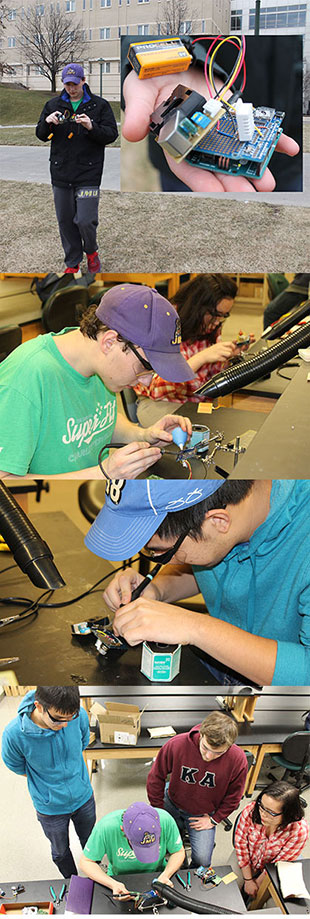Wearable air quality sensors: Student project gets EPA backing
NewsSUMMARY: Fast forward to fall 2015, when Henriques and Dr. Keith Holland, associate professor of engineering, received a $14,997 grant from the Environmental Protection Agency to fund the student project, which is now entered in the agency's annual People, Prosperity and the Planet (P3) Student Design Competition. The students will present their work in April in Washington, D.C., at the USA Science & Engineering Festival, hoping to get a $75,000 grant to continue refining and implementing the design.
 With nearly $15,000 already in their pockets, a group of JMU engineering students is hoping to earn $75,000 more this spring to create wearable air quality sensors.
With nearly $15,000 already in their pockets, a group of JMU engineering students is hoping to earn $75,000 more this spring to create wearable air quality sensors.
Why would anyone want to wear an air quality sensor?
Dr. Justin Henriques, assistant professor of engineering, started pondering that question about four years ago while bicycling to Oxford University, where he was doing post-doctoral work.
From his years as an undergraduate — Henriques earned a bachelor's degree in integrated science and technology at JMU in 2005 — he knew that exposure to emissions could change with the weather. "I'd be biking back and forth and I always sort of wondered, how is my exposure changing as the seasons are changing? And that sort of led down this path, well what if you could actually have a wearable air quality sensor that gave you feedback about the characteristics of the air you're breathing as you're living your life?"
Fast forward to fall 2015, when Henriques and Dr. Keith Holland, associate professor of engineering, received a $14,997 grant from the Environmental Protection Agency to fund the student project, which is now entered in the agency's annual People, Prosperity and the Planet (P3) Student Design Competition. The students will present their work in April in Washington, D.C., at the USA Science & Engineering Festival, hoping to get a $75,000 grant to continue refining and implementing the design.
"It's a neat experience for undergrads," said Henriques, who is co-advising the project with Holland. "They participate in the grant writing process and if it's awarded, they have a chance to work on the actual project and then present their first-year findings."
Poor air quality is a serious health problem worldwide. About 7 million deaths were attributed to air pollution in 2012 and two years later the World Health Organization cited air quality as the largest environmental risk.
Air quality is traditionally monitored by fixed stations. Wearable air quality sensors would collect data at various locations and times, data that would be advantageous for both individuals and communities, Henriques said. For example, he said, people who exercise outside could use the data to plan the best times and places for exercising. And communities could use the space and time data to make better policy decisions regarding air quality. Individuals and policy makers would access the data from a website where anyone with a wearable sensor could upload it.
Students majoring in industrial design, computer science and engineering started working on the project two years ago and a prototype has been created using 3D printers. The device is currently measuring ozone and particulate matter. It has GPS to monitor its location and an accelerometer to measure its movement. Data is being stored on an SD card.
"One of the challenges, at least with the technology we're working with now, is size," Henriques said, noting that the current prototype is about the size of a portable speaker. "If you could have something that is small enough, compact enough and had enough value to the user and you could crowd source that information, maybe you could start understanding the patterns of pollution."
In addition to refining the design, the team plans to start collecting data around Harrisonburg using six prototypes. One of the questions the team wants to answer, Henriques said, is if the units can collect data that is not necessarily better than existing monitoring stations, but different. After collecting data with their prototypes, they can compare it to data collected by traditional stations.
The students plan to hold a public forum this spring, before the design competition, to present their data and get feedback from attendees about what makes sense and what doesn't.
"Some of the students who have worked on this in the past are doing grad school or working in industry where they're building sensors," Henriques said. "So it has given them that experience and it also has given them experience, at least the last two years, of working with students from other majors."
The initial students who worked on the project were computer science majors Sang Cho, Alejandro Flores and Melissa Lynne Von Wald; engineering major Brian Bojarski; and industrial design major Kyle Byrd.
The current team consists of six engineering majors: Jonathan Romero, Benjamin Catlett, Nghi Dam, Andrew Ricketts, Dias Zhakypbay and Gene Stainback, and an industrial design major, Matthew Snow.
By Rachel Petty ('17), JMU Communications & Marketing

